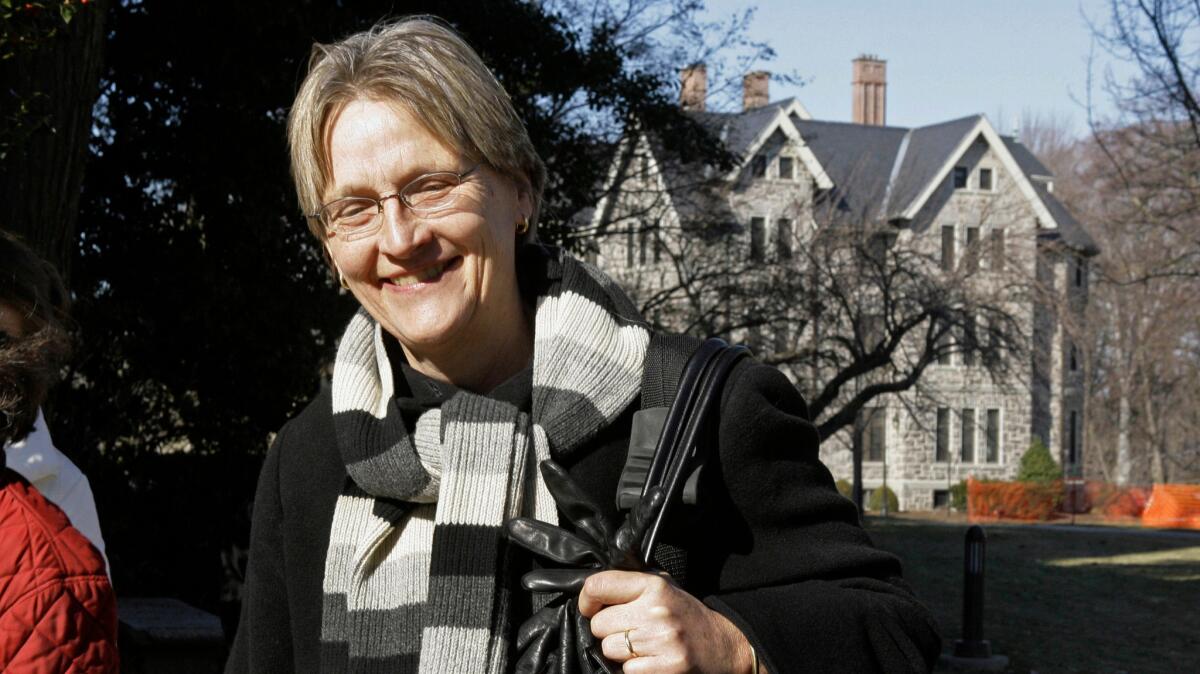Op-Ed: When women were admitted to Ivy League schools, the complaints sounded a lot like a Trump tweet

Whenever women make a claim on roles that have belonged to men, this is what they’re told: “You don’t belong.” “You can’t handle it.” Here are this year’s variations: “You don’t look presidential.” “You don’t have the stamina.”
The same negative litany was heard repeatedly when the historically male Ivy League colleges and universities were contemplating co-education. For generations it had been an article of faith that women did not belong there. When the men in charge of these institutions decided in the late 1960s that they had to admit women, it wasn’t out of high-minded regard for equal rights; they acted on the basis of self-interest. Applications from the most talented male high school students were starting to decline. Those young men — the colleges called them the “best boys” — wanted to go to college with women. Admitting women was a deliberate move on the part of schools such as Yale and Princeton to recapture their hold on talented men.
But where university administrators saw strategic advantage, many alumni saw heresy. My university, Princeton, affords a case in point.
A member of the class of 1936 objected to diluting ‘Princeton’s sturdy masculinity with disconcerting, mini-skirted young things...’
“If Princeton goes coeducational,” a member of the class of 1932 declared, “my alma mater will have been taken away from me, and PRINCETON IS DEAD.” A member of the class of 1936 objected to diluting “Princeton’s sturdy masculinity with disconcerting, mini-skirted young things cavorting on its playing fields.”
Disrupting the special spirit, the cherished all-male camaraderie that made Princeton so successful, was bad enough. Perhaps more important, as a member of the class of 1955 argued, educating women would diminish Princeton’s contribution to the nation’s service, since women would never use their “education and talents in public service to the same extent as a male who spends full time at his profession.” In short, “for every woman admitted to Princeton,” a man — a potential leader — “would be denied that opportunity.”
Princeton was by no means unique. The same objections to coeducation were heard at Yale, among other places. The president of Yale, Kingman Brewster Jr., caused a significant stir in the first year of undergraduate coeducation by assuring alumni that the university was committed to producing “1,000 male leaders,” making plain that undergraduate women were merely add-ons at Yale, and definitely not material for the halls of power.
Thirty years later, in the early 2000s, women would account for half the undergraduates at Harvard, Yale, Princeton and Dartmouth, and they were beginning to be named presidents of Ivy League universities. When Shirley Tilghman became president of Princeton in 2001, she named a woman as provost. Soon there were senior women administrators throughout the university: dean of the college, dean of the Woodrow Wilson School of Public and International Affairs, dean of engineering, dean of admission. One disgruntled member of the class of 1940 doubtless spoke for many alumni when he called the Princeton administration a “damned matriarchy.”
Misogyny is not such a surprising response to such a fundamental change. To retreat from such discomfort, condescension and anger, one needs to be able to imagine women as leaders. Proof of concept helps: Tilghman’s appointment at Princeton was soon followed by Amy Gutmann, who succeeded Judith Rodin at Penn, Ruth Simmons (and later Christina Paxson) at Brown, and Drew Gilpin Faust at Harvard. It is no longer surprising to find women in as many as half the presidencies in the Ivy League.
In the corporate world, too, it is no longer surprising to find women running Fortune 500 companies (Mary Barra at General Motors, Meg Whitman at Hewlett Packard Enterprise, Virginia Rometty at IBM, Irene Rosenfeld at Mondelēz International and Indra Nooyi at PepsiCo).
Every step of this kind matters. Each female CEO, governor, senator and Supreme Court justice is another proof of concept demonstrating that what men have done, women can do too. Their accomplishments expand our vision and set a context in which we learn to imagine women as leaders.
A century after American women won the right to vote, when women comprise more than half the population of the United States and more than half of American college students are women, it is beyond question that a woman would run for president. And it is wholly plausible that she not only looks the part but that she can succeed in the job.
Nancy Weiss Malkiel is the author of “ ‘Keep the Damned Women Out’: The Struggle for Coeducation.”
Follow the Opinion section on Twitter @latimesopinion and Facebook
ALSO
Bernie Sanders: Stand up to Big Pharma greed. Vote yes on Proposition 61
More flexibility over public worker pensions could help save them
In the Nixon-Humphrey election, I refused to vote for the ‘lesser of two evils.’ That was a mistake
More to Read
A cure for the common opinion
Get thought-provoking perspectives with our weekly newsletter.
You may occasionally receive promotional content from the Los Angeles Times.






